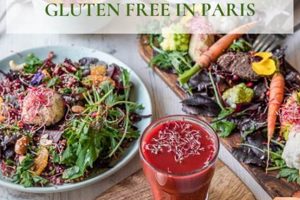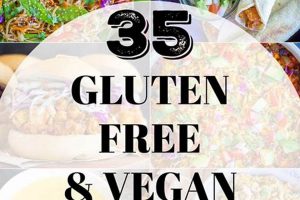The provision of meals and related services that exclude both gluten, a protein found in wheat, barley, and rye, and all animal products is a specialized area within the food service industry. This encompasses menus devoid of meat, dairy, eggs, honey, and other animal-derived ingredients, while also ensuring that dishes are prepared without any gluten-containing substances. Such a service might be employed for corporate events, private parties, or institutional settings where dietary restrictions are a priority.
Offering these specialized services addresses the increasing demand for inclusive culinary options driven by health concerns, ethical considerations, and lifestyle choices. Individuals with celiac disease, gluten sensitivities, or those adhering to a plant-based diet benefit directly. Furthermore, the availability of these options promotes inclusivity and demonstrates consideration for diverse needs. Historically, specialized dietary requirements were often overlooked, but the modern food industry is evolving to meet these demands more effectively.
This article will explore the key considerations involved in providing comprehensive options for events and gatherings. It will delve into menu planning strategies, ingredient sourcing best practices, preparation techniques that ensure both safety and flavor, and logistical factors involved in delivering these specialized services effectively.
Essential Considerations
The following guidelines are provided to ensure the successful execution of services tailored to meet specific dietary requirements.
Tip 1: Rigorous Ingredient Verification: Implement a strict verification process to confirm that all ingredients are certified gluten-free and plant-based. Cross-contamination is a significant concern; therefore, suppliers must provide documentation guaranteeing the absence of gluten and animal products throughout their production processes.
Tip 2: Dedicated Equipment and Preparation Zones: Establish designated preparation areas and utilize separate equipment to prevent cross-contamination. This includes cutting boards, utensils, cookware, and storage containers. Color-coding or labeling systems can aid in clearly distinguishing equipment used for different dietary needs.
Tip 3: Allergen Awareness Training: Mandate comprehensive training for all kitchen staff regarding allergen awareness and safe food handling practices. This training should cover the identification of common allergens, proper cleaning procedures, and strategies for preventing cross-contamination.
Tip 4: Transparent Menu Labeling: Provide clear and accurate menu descriptions that explicitly identify ingredients and potential allergens. Avoid ambiguous terms and use standardized terminology to ensure accurate communication of dietary information to consumers.
Tip 5: Comprehensive Recipe Development: Formulate recipes that prioritize flavor, texture, and nutritional balance while adhering strictly to dietary restrictions. Explore a diverse range of plant-based ingredients and innovative techniques to create satisfying and appealing menu options.
Tip 6: Detailed Documentation: Maintain meticulous records of all ingredients, recipes, and preparation procedures. This documentation serves as a valuable resource for quality control, traceability, and compliance with regulatory requirements.
Tip 7: Proactive Communication: Encourage open communication with clients to understand their specific dietary needs and preferences. This collaborative approach allows for customization of menus and ensures that all requirements are met with precision.
Adhering to these considerations ensures the delivery of safe, inclusive, and high-quality services. Careful attention to detail and a commitment to best practices are essential for establishing trust and satisfying the needs of diverse clientele.
The subsequent sections will address specific aspects of menu design and sourcing strategies to further enhance service offerings.
1. Ingredient Integrity
Ingredient integrity forms the cornerstone of reputable gluten-free vegan services. Within this context, integrity encompasses the comprehensive assurance that all components utilized are devoid of both gluten and any animal-derived substances. The absence of either compromises the integrity of the service offering, potentially causing adverse health reactions for individuals with celiac disease or undermining the ethical principles of veganism. The repercussions of compromised ingredient integrity range from mild discomfort to severe allergic responses, directly impacting client well-being and trust in the service provider. For example, the accidental inclusion of wheat-based soy sauce in a purportedly gluten-free vegan stir-fry would constitute a failure of ingredient integrity, with potential consequences for sensitive individuals.
The maintenance of ingredient integrity necessitates rigorous sourcing protocols, including supplier audits and the verification of certifications from recognized bodies. This involves not only scrutinizing the ingredient list but also examining the supplier’s manufacturing processes to identify potential sources of cross-contamination. Consider the case of a vegan cheese alternative manufactured on shared equipment with dairy products; without stringent separation and cleaning procedures, the products integrity is questionable. Proactive measures, such as laboratory testing for gluten and animal-derived proteins, further reinforce the assurance of ingredient integrity. Documenting these efforts builds a transparent supply chain, facilitating traceability in the event of contamination incidents.
In conclusion, ingredient integrity is not merely a desirable attribute, but a non-negotiable imperative for credible gluten-free vegan services. Maintaining this integrity requires a multi-faceted approach, encompassing rigorous sourcing, meticulous process controls, and proactive verification measures. The challenges are significant, demanding constant vigilance and a commitment to transparency. However, the benefitssafeguarding consumer health, upholding ethical values, and fostering trustoutweigh the costs. Failure to prioritize ingredient integrity ultimately undermines the viability and reputation of the service itself, demonstrating its intrinsic link to the broader goals of inclusive catering.
2. Cross-contamination prevention
In the context of gluten-free vegan offerings, cross-contamination prevention is not merely a procedural step but a critical determinant of service integrity and consumer safety. The introduction of gluten or animal products, even in trace amounts, can have significant adverse effects on individuals with celiac disease, gluten sensitivities, or those adhering to vegan principles. Thus, the implementation of rigorous preventative measures is paramount.
- Dedicated Kitchen Spaces and Equipment
The allocation of separate preparation areas and equipment exclusively for gluten-free vegan meals minimizes the risk of unintended contact with gluten or animal-derived substances. This includes distinct cutting boards, utensils, cookware, and storage containers. For example, using the same deep fryer for french fries and breaded chicken nuggets poses a high risk of cross-contamination, rendering the fries unsuitable for gluten-free or vegan consumers.
- Strict Cleaning and Sanitization Protocols
Thorough cleaning and sanitization of all surfaces and equipment before and after use are essential. This involves employing specialized cleaning agents effective in removing both gluten and animal proteins. A failure to adequately sanitize a countertop after preparing a sandwich containing mayonnaise, for example, could contaminate subsequent gluten-free vegan preparations.
- Ingredient Storage and Handling Procedures
Proper storage of ingredients is crucial to prevent cross-contamination. Gluten-free and vegan ingredients should be stored in sealed containers, clearly labeled, and physically separated from other items. Overlapping storage of wheat flour and gluten-free flour can lead to accidental contamination, necessitating the discarding of the compromised ingredients.
- Staff Training and Awareness
Comprehensive training for all kitchen personnel is necessary to ensure adherence to cross-contamination prevention protocols. This includes educating staff on the sources of gluten and animal products, proper handling techniques, and the importance of maintaining separate workspaces and equipment. A staff member unaware of the gluten content in soy sauce, for instance, might inadvertently introduce it into a gluten-free dish.
The preceding facets highlight the multifaceted nature of cross-contamination prevention in specialized culinary services. While seemingly straightforward, the consistent application of these practices requires a dedicated commitment and ongoing vigilance. The absence of robust preventative measures jeopardizes the integrity of gluten-free vegan catering, potentially leading to health risks and a loss of consumer confidence. Conversely, a proactive approach demonstrates a commitment to safety, quality, and customer satisfaction.
3. Nutritional Adequacy
Nutritional adequacy is a central consideration within gluten-free vegan services, requiring a meticulous approach to menu planning and ingredient selection. Eliminating both gluten and all animal products necessitates a heightened awareness of potential nutrient deficiencies and the strategic incorporation of alternative sources.
- Protein Sources
Meeting protein requirements within this dietary framework relies on a diverse array of plant-based sources. Legumes (beans, lentils, peas), tofu, tempeh, edamame, nuts, seeds, and gluten-free grains such as quinoa and amaranth are essential components. Insufficient protein intake can lead to muscle loss, impaired immune function, and hormonal imbalances. For instance, a menu solely reliant on leafy greens and root vegetables will likely be deficient in essential amino acids and overall protein content.
- Vitamin B12
Vitamin B12 is predominantly found in animal products, making supplementation or the inclusion of fortified foods critical for individuals following a vegan diet. Deficiency can result in neurological damage and anemia. Fortified nutritional yeast, plant-based milks with added B12, and B12 supplements are practical means of ensuring adequate intake. Relying solely on unfortified plant-based options will invariably lead to a B12 deficiency.
- Iron and Calcium
Plant-based sources of iron and calcium are available but often less readily absorbed than their animal-derived counterparts. Iron-rich foods include lentils, spinach, and fortified cereals, while calcium can be obtained from fortified plant-based milks, tofu processed with calcium sulfate, and leafy green vegetables. Enhancing iron absorption can be achieved by consuming vitamin C-rich foods concurrently. For example, combining a lentil stew with a squeeze of lemon juice improves iron bioavailability. Insufficient intake of these minerals can compromise bone health and lead to iron-deficiency anemia.
- Omega-3 Fatty Acids
Obtaining adequate omega-3 fatty acids, particularly EPA and DHA, can be challenging on a vegan diet. Alpha-linolenic acid (ALA), a precursor to EPA and DHA, is found in flaxseeds, chia seeds, walnuts, and hemp seeds. However, the conversion of ALA to EPA and DHA is often inefficient. Algae-based EPA and DHA supplements offer a direct source of these essential fatty acids. Excluding these sources can lead to deficiencies in omega-3 fatty acids, potentially impacting cardiovascular and cognitive health.
The nutritional adequacy of gluten-free vegan services hinges on a thorough understanding of potential nutrient gaps and the strategic selection of nutrient-dense, bioavailable alternatives. Without careful planning, these dietary restrictions can lead to deficiencies with significant health implications. Successful implementation requires a commitment to providing balanced and diverse menus that prioritize nutritional well-being.
4. Flavor profile development
Flavor profile development is a crucial aspect within gluten-free vegan catering due to the inherent limitations imposed by these dietary restrictions. The absence of gluten, a common binder and textural element, and animal products, which often contribute to richness and umami, necessitates a strategic approach to crafting satisfying and complex tastes. The success of such catering hinges on the ability to create appealing dishes that compensate for these omissions through alternative ingredients and culinary techniques. For instance, replacing wheat-based pasta with gluten-free alternatives can significantly alter the texture and flavor; therefore, sauces and accompanying elements must be designed to complement these changes effectively.
The development of compelling flavor profiles in this context relies on a deep understanding of plant-based ingredients and their interactions. Techniques such as roasting vegetables to enhance sweetness and depth, employing umami-rich ingredients like mushrooms and seaweed, and utilizing aromatic spices and herbs are essential. The skillful combination of these elements can create dishes that are both flavorful and nutritionally balanced. Consider the application of smoked paprika, which can impart a savory, meaty flavor to lentil-based dishes, or the use of citrus zest and fresh herbs to brighten vegetable-based soups. The ability to build layered and complex flavors is paramount in overcoming the perception that gluten-free vegan cuisine lacks depth or satisfaction.
Ultimately, flavor profile development in gluten-free vegan catering represents a culinary challenge with significant implications for consumer satisfaction and the broader acceptance of these dietary options. Successfully navigating this challenge requires chefs to be innovative, knowledgeable, and attentive to the nuances of plant-based ingredients. The creation of appealing and flavorful dishes can elevate gluten-free vegan catering from a niche offering to a mainstream culinary experience, addressing the needs of a growing population with specific dietary requirements. The continuous exploration of new ingredients and flavor combinations remains essential to expand the possibilities and dispel any preconceived notions about the limitations of this culinary field.
5. Menu diversification
Menu diversification within gluten-free vegan catering extends beyond simply offering a few alternative dishes. It necessitates a deliberate and comprehensive approach to providing a range of options that cater to diverse preferences, nutritional needs, and culinary expectations. The goal is to ensure that individuals with dietary restrictions can enjoy a satisfying and varied dining experience comparable to that available to those without such constraints.
- Addressing Diverse Dietary Needs
Diversifying menus involves acknowledging that gluten-free and vegan diets are not monolithic. Individuals may have additional allergies, sensitivities, or specific nutritional requirements. For example, some may need low-sodium options, while others may seek high-protein choices for athletic performance. Failure to address these nuances limits inclusivity and overall satisfaction.
- Seasonal Ingredient Incorporation
Utilizing seasonal ingredients enhances flavor profiles, supports local agriculture, and adds variety to the menu throughout the year. A summer menu might feature grilled vegetables and fresh fruit salads, while an autumn menu could incorporate squashes, root vegetables, and hearty grain dishes. This strategy prevents menu fatigue and showcases culinary creativity.
- Global Cuisine Inspiration
Drawing inspiration from global cuisines broadens the culinary landscape and introduces new flavors and textures. Indian curries, Thai stir-fries, Mediterranean salads, and Mexican-inspired dishes can be adapted to be both gluten-free and vegan. This approach avoids reliance on repetitive recipes and expands the range of appealing options.
- Creative Ingredient Utilization
Exploring innovative ways to use plant-based ingredients is essential for menu diversification. Aquafaba (chickpea brine) can be used as an egg white substitute in desserts, while jackfruit can mimic the texture of pulled pork. Experimentation with lesser-known grains, legumes, and vegetables can lead to unique and satisfying dishes. This approach fosters culinary innovation and distinguishes the catering service from competitors.
These facets of menu diversification are interconnected and collectively contribute to the overall success of gluten-free vegan catering. By offering a wide array of options that cater to diverse needs and preferences, culinary professionals can ensure that individuals with dietary restrictions have access to a satisfying and enriching dining experience. This not only enhances customer satisfaction but also promotes inclusivity and expands the appeal of plant-based cuisine.
6. Supply chain transparency
Supply chain transparency is not merely a desirable attribute but a fundamental requirement for credible gluten-free vegan catering services. The assurance that ingredients are genuinely devoid of gluten and animal products hinges on the ability to trace their origins and verify processing methods. This traceability is critical for mitigating risks associated with cross-contamination and ensuring adherence to ethical sourcing principles.
- Ingredient Origin Verification
Transparency necessitates the ability to identify the original source of each ingredient. This involves documenting the farms, producers, or suppliers responsible for cultivation or manufacture. For instance, knowing the origin of a batch of gluten-free oats allows caterers to assess the likelihood of field contamination with wheat or barley. This verification process is essential for ensuring that ingredients align with dietary specifications.
- Processing Method Disclosure
Detailed disclosure of processing methods is crucial for assessing potential cross-contamination risks. This includes understanding how ingredients are handled, stored, and transported throughout the supply chain. A supplier of vegan cheese alternatives, for example, must provide assurances that their manufacturing facility maintains strict separation between dairy and non-dairy production lines. Such disclosure enables caterers to evaluate the effectiveness of contamination control measures.
- Certification and Auditing Protocols
Transparent supply chains often rely on third-party certifications and auditing protocols to validate claims of gluten-free and vegan status. These certifications, such as those from recognized vegan organizations or gluten-free certification programs, provide independent verification of supplier practices. Regular audits by accredited bodies ensure ongoing compliance with established standards. Reliance on these certifications strengthens the credibility of the catering service.
- Traceability and Recall Systems
Robust traceability systems are essential for managing potential food safety incidents. These systems allow caterers to quickly identify the source of contaminated ingredients and initiate targeted recalls. A clear audit trail enables swift removal of affected products from the supply chain, minimizing the risk of harm to consumers. The absence of such systems can lead to widespread contamination and significant reputational damage.
In conclusion, supply chain transparency is inextricably linked to the integrity of gluten-free vegan catering. Without the ability to verify ingredient origins, processing methods, and adherence to established standards, caterers cannot confidently assure consumers that their dietary requirements are being met. The implementation of robust transparency measures is therefore a critical investment in consumer safety, ethical sourcing, and the long-term viability of the business.
7. Staff training protocols
Effective staff training protocols are a critical determinant of success in gluten-free vegan catering. The preparation of meals adhering to these dietary restrictions demands a level of precision and awareness exceeding that of standard culinary practices. Inadequate training can lead to cross-contamination, misidentification of ingredients, and ultimately, adverse health consequences for consumers with allergies or ethical objections to animal products. For example, untrained staff may inadvertently use utensils that have come into contact with gluten-containing ingredients, thereby compromising the gluten-free status of a dish. This necessitates comprehensive training modules addressing ingredient identification, safe food handling practices, and cross-contamination prevention techniques.
The scope of staff training should encompass a detailed understanding of both gluten-free and vegan dietary requirements. This includes identifying common sources of gluten (wheat, barley, rye) and animal products (meat, dairy, eggs, honey, gelatin). Moreover, training must emphasize the importance of reading ingredient labels carefully, verifying certifications, and questioning suppliers regarding processing methods. Consider the example of soy sauce, which often contains wheat-derived ingredients unless explicitly labeled as gluten-free. Staff must be able to identify such potential hazards and make informed decisions to ensure the integrity of the meal. Practical applications of this training include mock scenarios simulating real-life kitchen situations where cross-contamination risks are present. These exercises reinforce proper procedures and build confidence among staff members.
In conclusion, robust staff training protocols are an indispensable component of gluten-free vegan catering. The commitment to comprehensive training not only minimizes risks but also enhances the credibility and reputation of the service. Challenges in implementation include the cost of training programs and the ongoing need for reinforcement. However, the benefits of a well-trained staffoutweigh the costs, ensuring the safety and satisfaction of consumers and contributing to the sustainable growth of the business. The connection between staff training and the success of gluten-free vegan catering is undeniable, underscoring its significance in this specialized culinary field.
Frequently Asked Questions
The following addresses common inquiries regarding services offering culinary options free from both gluten and animal products. Information presented aims to clarify expectations and provide a deeper understanding of the complexities involved.
Question 1: What distinguishes services from standard catering offerings?
This specialization entails a rigorous exclusion of all gluten-containing ingredients, such as wheat, barley, and rye, as well as all animal-derived products, including meat, dairy, eggs, and honey. Standard catering may not adhere to these strict exclusions.
Question 2: How is cross-contamination prevented in preparation?
Reputable providers employ dedicated kitchen spaces, equipment, and utensils to prevent cross-contamination. Stringent cleaning protocols are implemented, and staff undergo comprehensive training on allergen awareness and safe food handling practices.
Question 3: Can services accommodate additional dietary restrictions or allergies?
Many providers offer customization options to address additional dietary needs, such as nut allergies, soy sensitivities, or specific carbohydrate requirements. Communication regarding specific dietary needs is essential during the planning process.
Question 4: What types of cuisines are typically available?
A diverse range of cuisines can be adapted to meet needs, including but not limited to: Mediterranean, Asian, Mexican, and American. The availability of specific cuisines may vary depending on the provider.
Question 5: How does pricing compare to standard catering services?
Pricing may vary depending on factors such as menu complexity, ingredient sourcing, and service level. Costs may be comparable to or slightly higher than standard catering due to the specialized nature of the ingredients and preparation.
Question 6: How are nutritional needs met within these dietary constraints?
Skilled chefs and nutritionists carefully plan menus to ensure adequate intake of essential nutrients, such as protein, iron, calcium, and vitamin B12, utilizing diverse plant-based sources and fortified foods where necessary.
Understanding these aspects allows for informed decision-making when considering this specialized culinary service.
The subsequent section will explore considerations for selecting a provider.
Gluten Free Vegan Catering
This exploration of gluten-free vegan catering has underscored the complexities inherent in providing safe, nutritious, and appealing meals that adhere to these dietary restrictions. Key considerations include rigorous ingredient verification, prevention of cross-contamination, nutritional adequacy, creative flavor profile development, diverse menu offerings, transparent supply chains, and comprehensive staff training. Each element is crucial for maintaining the integrity of the service and ensuring consumer well-being.
The increasing demand for catering options that accommodate specific dietary needs highlights the importance of adhering to the highest standards of practice. Continued vigilance and a commitment to excellence are essential. Professionals and consumers must remain informed and proactive in advocating for transparency, safety, and inclusivity within the food service industry. Prioritizing the health and ethical considerations of clients with specialized requirements is non-negotiable.







